Environmental Sound, Sonic Art, Physical Computing, Performance
Michaela Palmer Academic Life
Programme Leader Lecturer Researcher Practitioner
Programme Leader of the BSc Digital Media at UWE Bristol, a creative and technical award with an industry-ready curriculum. Experienced External Examiner at other UK universities.
Extensive teaching experience within UK Higher Education. Higher Education Academy Fellow (FHEA), PGCE holder, BIMA member, winner of UWE Teaching Excellence Award 2010 and Teacher of the Year 2019. Michaela's teaching style is experiential and engaging, with a long-standing experience in dissertation supervision and practice-led research.
PhD 'Listening to the Mind at play – sonified biofeedback as generative art practice and theory', 2010. Current research interests include: Sonic Art, Environmental Sound Art, Sonification, Play and Interaction, Generative Processes in Art and Music, Physical Computing.
Sound practitioner, International Computer Music Association (ICMA) member.
Academic Experience
As a Programme Leader at UWE Bristol I lead a small team of experienced practitioner-educators. We strive to keep our digital media curriculum attractive to students and industry-relevant. The latest innovation is the forthcoming Design Enterprise Studio, a student consultancy project module and incubator for young professionals in the creative technologies area.
Over the past years I have also been forging stronger links with local industry, designing and validating Masters courses, organised research conferences, and successfully led undergraduate and postgraduate modules in Digital Arts, Digital Media and Music Technology subjects. I have won funding for STEM outreach workshops with local communities in Bristol.
Teaching & Learning
My teaching expertise in digital media spans across design, coding and media production. In these practice-based areas experiential learning is often key. In terms of teaching methods, this requires experimentation, iterative practice development and reflection in action; offering a student-centered approach that allows learners to immerse themselves in topics in greater depth, providing rich learning opportunities based on a creative and technical project.
My teaching and learning approach often goes beyond the conventional classroom setting involving not only first hand evaluation of technologies and exploration of virtual environments but also studio visits, work experience opportunities and field trips to digital media events.
I my view a creative design process often works best when informed by a sound understanding of its users and stakeholders, so a grounding in qualitative research is important. Pairing human design aspects with technical expertise means students have a great starting point for their future careers after graduation.
Some examples of undergraduate and postgraduate project supervisions:
Projection Mapping
A number of audio-visual projects, created by Sonic Art students, were exhibited at the UWE Bristol Colston Hall Showcase exhibition in January 2020. The video files were projection mapped onto an object in a gallery space, making use of gravity suggested in the video files and immersive sound.
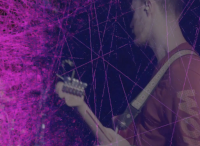
Audio Reactive Visualizer
by Edan Brown. Software application in Max MSP, using Jitter and OpenGL. The project allows bands to generate audio reactive visuals in real time. The application allows for simple beat detection, note estimation as well as user-assigned colour schemes for the full musical scale.
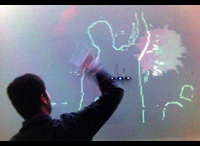
Wiimote Action Painting
by Angelos Panayides. A software application that interfaces a Nintendo wiimote with Max/msp/jitter. In addition to the wiimote data, a camera tracks players in real-time, so they can observe their actions as well as the result of their actions, which makes for a fascinating play experience.
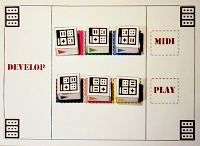
Generative Melody Maker
by James Llewellyn. Software application developed in Juce, using a genetic algorithm to initiate and evolve melodies. Interfaced with d-touch, a visual marker recognition system to enable a low-cost tangible solution. Users create and refine melodies before exporting them as midi files.
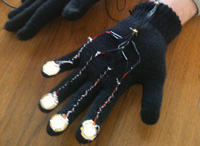
Vocaliser Gloves
by Alison Warlow. Early prototype sensor gloves which could be worn by vocal performers on stage as well as during studio recording sessions. The gloves provide an intuitive interface with which to layer vocal recordings, add effects and create loops, without having to leave the mic.
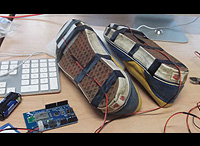
Beat Sneakers
by Hugo Bishop, Piran Watson, Adam Khadaroo and Louis Catlett. An arduino-based sensor interface that translates players' tapping of the feet and legs into drum sound samples which are played back to the player. This 'portable drum kit' was to allow drummers to practice on the go.
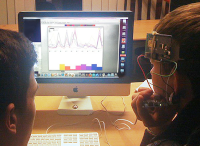
Thabre
by Steffan Chelland, Adrian Memed and Ewan Edwards. A real-time sonification of brainwave data. Users see their brainwave visualised and decide how they want it to sound. To help prolong the presence of alpha-waves, users can choose from a range of sample banks.
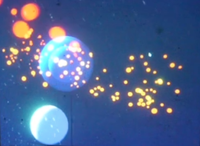
Music Visualizer
by Nicholas Allan. A number of graphical objects react independently to different audio attributes. In contrast to ready-made visualisers, this one is highly autonomous, reacting to midi values derived from audio files automatically. Implementation in Quartz Composer.
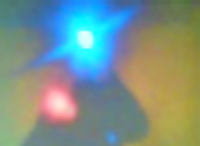
Colour Tracking Visualizer
by Patrick Shuttleworth. A colour tracking interface for a red and a blue light source. The aim was to develop an intuitive system that would enable artists, DJs, musicians and sound engineers to control audio & visual parameters through their body movements.